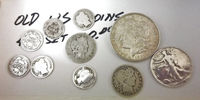Posted on April 21, 2022

By Paul Vanguard, for BullionMax.com
The decision by the U.S. Mint to remove silver from all circulating coins in 1965 and 1970 tells us a few things. Silver was getting rarer and more expensive, and the U.S. Mint was quick to adapt. We were already moving away from real money, and the dollar was all too soon to follow. Just look at the denominations of these old silver coins and you can actually see the concept of “money” drifting farther and farther away from “value.”
A $0.25 Standing Liberty, minted between 1916-1930 and worth twenty-five cents has a modern-day melt value of $4.45. What happened?!?
Well, the U.S. left the gold standard in 1972. Paper dollars were no longer legally exchangeable for a defined quantity of gold (not even a ridiculously small quantity of gold). This departure from economic reality also allowed our great nation’s central bank, the Federal Reserve, to issue any quantity of paper money without limit.
And they did… Over the last 50 years, the number of dollars in circulation has increased over thirty-fold. It looks like this:
As paper dollars became increasingly abundant, their ability to actually buy anything shrank.
 Some people describe this as gold and silver’s price rising. In my mind, it’s more like that scene from Honey, I Shrunk the Kids – the kids (dollars) shrunk, while everything else stayed the same size.
Some people describe this as gold and silver’s price rising. In my mind, it’s more like that scene from Honey, I Shrunk the Kids – the kids (dollars) shrunk, while everything else stayed the same size.
So, once there was no link between dollars and physical precious metals, the dollar’s value shrank. The melt value of the pocket change coined for decades became worth more than dollar bills, vastly more than their face value (as we saw in the Standing Liberty quarter example).
Note: I actually wanted to call this post Honey, I Shrunk the Dollar, but the other guys said this was a terrible idea.
Any U.S. non-penny coin minted before 1965 is partially silver – either 90%, 40% or 35%.
A good way to tell if your pocket change has silver is to find out whether it was issued in 1964 or earlier. If it was, it probably does.
Examples of coins issued between 1892 and 1964 that definitely have silver in them include:
Barber, Mercury and Roosevelt dimes
Barber, Standing Liberty and Washington quarters
BBarber, Walking Liberty, Franklin and Kennedy half-dollars
Some 1942-1945 wartime nickels
In the precious metals industry, a lot of dealers sell pre-1964 circulated silver coinage under the catch-all term “junk silver.” Junk silver coins are generally sold for silver content and normally fetch a price ranging from $1-$20 per coin. As you’d expect from the name, junk silver coinage has been circulated. It’s been places and seen things. It’s passed from hand-to-hand so many times you may not even be able to tell which president’s on the obverse. So don’t buy junk silver for its numismatic value, because there isn’t any.
Before we get deeper into the value, let's just get the cleaning part out of the way, and it's an easy one.
Whatever they might look like, the wear and tear is adding appeal to buyers. They call it “patina” on Antiques Roadshow, or cachet in France. It's a selling point of its own, and also a selling point of metals as money. Retaining value despite wear and tear, in this disposable age? What more can you ask for?
Now, it is okay to brush off easily-removable dirt – but even that is optional and should be minimized. If you get out the silver polish and take a Brillo pad to your tarnished Mercury dime, then you are a villain.
As for market value, it depends on whether the coin is standard circulation or rare. This is why it's important to get every coin assessed by a reputable expert. One such company mentions a client who came in with a box of dimes filled by her parents over the course of their lives. After inspection, the box was revealed to be full of silver-containing dimes with a total value of $5,000-$10,000.
Then we get into the more exotic examples. There are many, so we'll stick with the dimes. The value of these comes from mishaps during minting, and they’re often called mis-strikes. Let's say a mint churns out 100,000 dimes, but it botches something on 100 of those, making them look different. These 100 are what collectors pay a pretty penny – usually, way, WAY more – to get their hands on.
The handmade Bust dimes from the 19th century have plenty of examples. A 1796 Bust dime can go for $2,650. An 1863 Seated Liberty can fetch between $400-$1,300. There are 1874 CC Seated Liberty dimes that go for over $65,000. Multiple 1965 Roosevelt dimes with errors were auctioned over the past decade, with prices ranging from $3,818 to $16,450.
Finding a collector's coin stashed somewhere can make anyone's day, and you should get anything that looks rare assessed by a professional. But, as the dime-box example showed, even a pile of standard-issue coins from decades past can turn out to be a treasure chest.
Paul Vanguard is a lifelong precious metals enthusiast and a proud member of the BullionMax team.